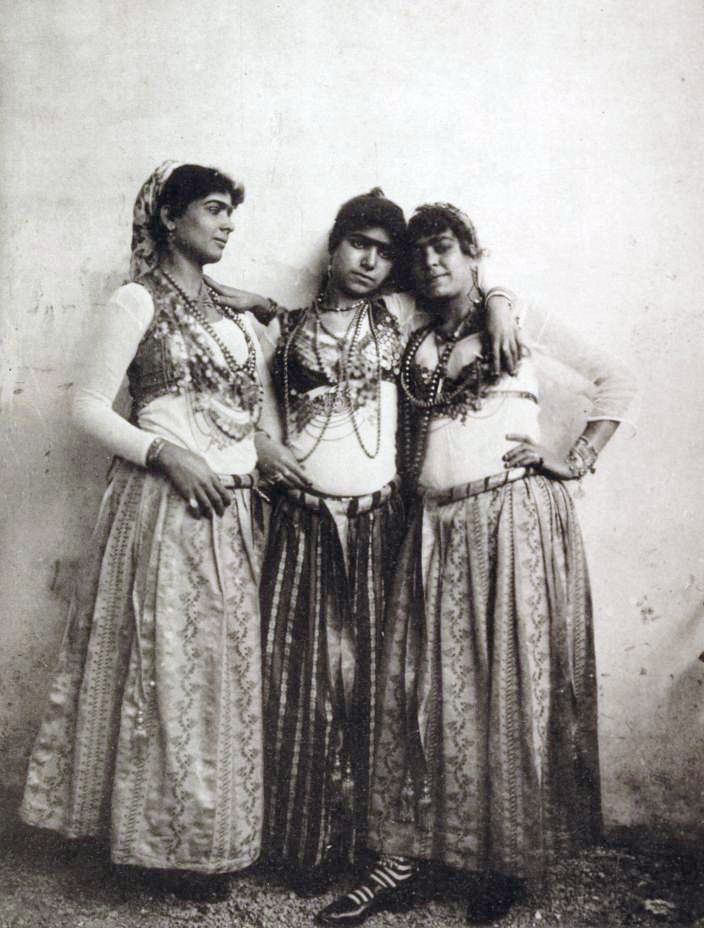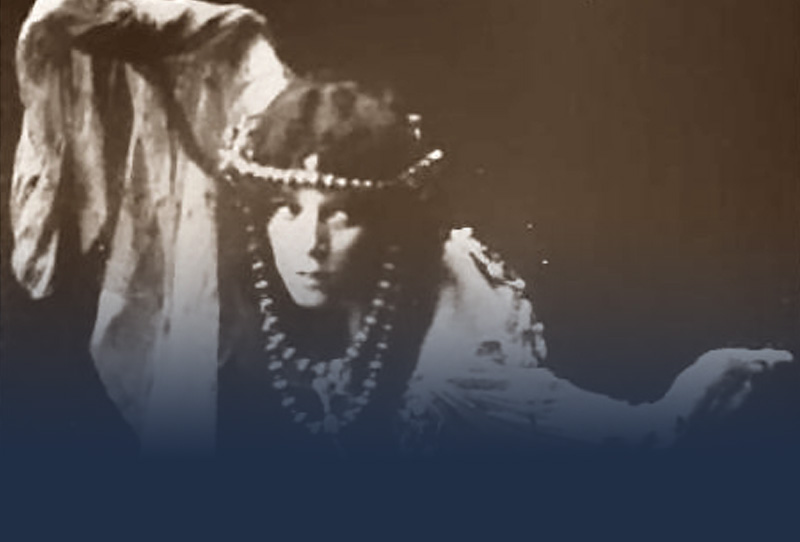Habibi: Vol. 3, No. 9 (1977)
Ever since the culture shock of the Middle Eastern dancers who appeared on the streets of Cairo at the Chicago World’s Fair in 1893, the dance has been imitated by Western women who “claim” Arab ancestry to create an air of credibility and mystery. What our Victorian forefathers saw were Middle Eastern ladies who were physically uninhibited, a shocking contrast to the restrained lady at the turn of the century. Censorship and negative publicity aroused curiosity and brought in the crowds. In an attempt to imitate Eastern dress, American women posed in pseudo-turbaned scanty drapings. Twenty or so years after the Chicago World’s Fair, Americans were photographed semi-nude in assuit, a silver Egyptian cloth, purchased by merchants at the fair. Aubrey Beardsley probably saw what he unflatteringly drew later on as the stomach dance, at the Paris Exposition of 1889. It is interesting to note that it was not known as the belly dance at that time, and Beardsley’s sketches were commissioned to illustrate the play Salome, written by Oscar Wilde.

Léon Bakst was an innovative costume designer who sketched and executed many of the oriental costumes for Sergei Diaghilev and the Ballet Russes at the turn of the century. He was the inspiration for costumes designed for Theda Bara which set the stage for the era of the vamp. The Diaghilev Company toured the United States in 1917, bringing the splendor of the Orient with the ballet Scheherazade. Vaslav Nijinsky was the feature dancer in the company who was assisted by prancing houris, dripping in pearls and stones, thrilling audiences from coast to coast. The influence of Bakst on oriental costume designers is felt to the present day. He is known as the father of costume design.
A preface to a 1911 book on classical dance states, “In writing of dancing one will therefore include those gesticulations or movements of the body suggesting an idea…It is not intended here to include the more sensual movements of the East and the debased antique” ¹. What was secretly admired was disapproved of in public. Most of the pictures taken of the dancers at the Chicago World’s Fair were captioned with derogatory descriptions of the dance and music. Though the audience was male, American women in their quest for sexual freedom and expression shed their more confining garments and, without having seen it, imitated “the dance of infamy”. The silent movie Salome, starring trained ballerina Alla Nazimova, serves as an example of the negative stereotype of Middle Eastern dance and the folly of the femme fatale.²

In contrast to dancers in the 20th century, the dancers of the 19th century and before were born into a family or tribe of dancers, and thereby, inherited the profession. When a girl was born into a tribe of musicians and dancers, the learning process began in infancy, and she made her debut when she reached puberty. The tribal dancers were some of those who were brought to the Chicago World’s Faire in 1893. On the walls of the theatre were painted signs, “Bedouin beauties of the Ouled Naïl tribe”, the famous dancers from Algeria. The famous Ghawazee dancing tribe from Egypt was also represented. The earliest description of their dances dates back to the poet Martial about 100 B.C., while he was in Spain. In a description of the Ghawazee who came to the Chicago World’s Faire, an Englishman by the name of Jeremiah Lynch describes their heritage and appearance.

The Ghawazee, who are raised in upper Egypt, though a few come from Syria, are trained from birth. Their limbs and bodies, from constant attention and practice, are as supple and flexible as those of an American acrobat. They are selected for their beauty of face and figure, and if their girlhood years do not in this regard fulfill the promises of childhood, they are at once discarded. After the age of twenty or twenty-two, they quit the profession, for from that period the body does not appear to possess the same lightness and agility. ³ ⁴

“Belly dance” is an American term that probably emerged after World War II when the dance became popular in nightclubs. Before that, it was condescendingly called the Hoochie Koochie, a phrase used by Sol Bloom who brought the Algerian dancers to the 1893 Chicago World’s Faire. The French called it the danse du ventre which literally translates into “dance of the abdomen”.
The nineteenth century was one of the most informative periods for the investigation of the danse du ventre. While France occupied a large portion of the Middle East, some of her countrymen visited, others assimilated and made it their home. Artists like Nasreddine Dinet, Jean-Léon Gérôme, and their contemporaries vied with each other while searching out their dreams in the desert, palace, and seraglio. Mysticism and romanticism of all things Eastern were popular in the novels of the day. Even now we look back to experience vicariously the expeditions of countless travelers who fled Europe in search of idealistic abstractions. Some of the artists painted oriental women with European faces. Others, who did not paint, described things to artists who were painted imaginatively, but incorrectly. Along with pilgrimages to the pyramids, the English and French have preserved for us in their art and writing the Arab world as it was before Europeanization and finally westernization.
This article was published in Jamila’s Article Book: Selections of Jamila Salimpour’s Articles Published in Habibi Magazine, 1974-1988, published by Suhaila International in 2013. This Article Book excerpt is an edited version of what originally appeared in Habibi: Vol. 3, No. 9 (1977).
¹ An Antiquary, The Dance: Historic Illustrations of Dancing from 3300 B.C. to 1911 A.D (London: John Bale, Sons and Danielsson, Ltd, 1911).
² Salome, dir. Charles Bryant (Nazimova Productions, 1923).
³ Jeremiah Lynch, Egyptian Sketches (London: Edward Arnold, 1890).
⁴ The reader may find it interesting to explore and research the conflicting opinions written by various observers as to the character of the Ghawazee.
Photo Credits:
- The Dancers Reward for Oscar Wilde\’s Salome, 1893, Aubrey Beardsley, Wood block carving, Public Domain. https://commons.wikimedia.org/wiki/File:Aubrey_Beardsley_-_The_Dancers_Reward.jpg
- Sketch for the costume of the pilgrim for the ballet: Le dieu bleu, (1912), Pencil, watercolor, gouache, and silver paint, Leon Bakst, Public Domain. https://commons.wikimedia.org/wiki/File:L%C3%A9on_Bakst_(1867-1927),_Le_Dieu_Bleu,_1912_-_Costume_of_the_pilgrim,_Sketch.jpg
- Salomé is a 1923 American silent drama film starring Nazimova, 1923, Nazimova Productions, Public Domain. https://commons.wikimedia.org/wiki/File:Salome-lobbycard-1923.jpg
- Gléon, Delort de. L\’architecture arabe des Khalifes d\’Egypte à l\’Exposition Universelle de Paris en 1889. La Rue du Caire. E. Plon, Nourrit: Paris, 1889. P 67, Creative Commons SA 2.5 Generic. https://commons.wikimedia.org/wiki/File:Types_de_danseuses_indig%C3%A8nes_(1889)_-_TIMEA.jpg
- Siren of the Nile, by Hy Hintermeister, 22 April 1927, Public Domain. https://commons.wikimedia.org/wiki/File:Siren_of_the_Nile_by_Hy_Hintermeister.jpg


